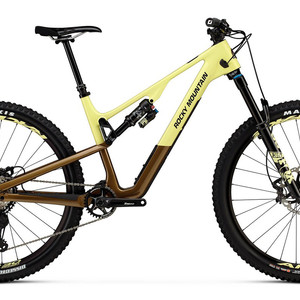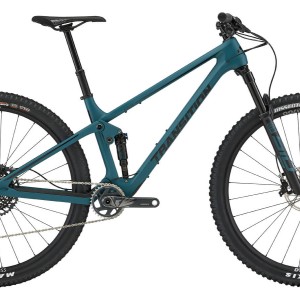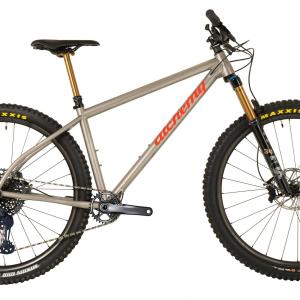2014 GT Sensor Carbon Pro
(discontinued)
| Where To Buy | |||
|---|---|---|---|
Free shipping on orders over $50 (continental U.S. only).
International shipping available. Some exclusions apply. |
|||
Free shipping on orders over $50 (continental U.S. only).
International shipping available. Some exclusions apply. |
|||
Reviewed by Evan Turpen, Steve Wentz and Brandon Turman // Photos by Shawn Spomer and Lear Miller
With 130mm of travel and a very unique suspension design, the all-new GT Sensor aims to tackle the trail market and is Hans Rey's go to ride. Everything from the headtube to the dropouts has been re-worked from the Sensor of old. Gone is the high bottom bracket and short top tube, in is more modern geometry, 27.5-inch wheels, and a roomy cockpit. Curious to see how the changes impact the ride, we pounded out several miles aboard the Sensor Carbon Pro during the 2014 Vital MTB Test Sessions.

Sensor Carbon Pro Highlights
- Carbon frame
- 27.5-inch wheels
- 5.1-inches (130mm) rear wheel travel
- Angle Optimized Suspension system
- Tapered headtube
- 68.5-degree head angle
- 73.5-degree seat tube angle
- 13.2-inch (335mm) bottom bracket height
- 17.3-inch (440mm) chainstay length
- Threaded bottom bracket
- 142mm x 12mm thru-axle
- Measured weight (size Medium, no pedals): 27-pounds 8-ounces (12.47kg)
- $7,050 MSRP
The 2014 Sensor was in development for over two and half years. During that time they took a long hard look at their I-Drive suspension design, bringing linkage mastermind Peter Denk into the picture. The redesigned Sensor uses a new “Angle Optimized Independent Drivetrain Suspension" system (AOS), which maintains the high pivot point while making the rear end lighter and stiffer than before. According to GT, the overall effect is a more responsive bike with better pedaling characteristics and limited chain growth.

They key to AOS is the grey colored Path Link, which connects the shock mount to the chain stays with the bottom bracket in-between. Similar to the previous I-Drive iteration, the bottom bracket is removed from the front triangle. GT wanted to keep the benefits of I-Drive (high pivot location and wheel path), but make it simpler with a lower center of gravity. When the suspension compresses, the bottom bracket moves backward to control chain growth, one of the main drawbacks of high pivot systems. The design has a relatively high leverage rate (2.75-2.95) that is generally regressive through the stroke.

There’s a lot going on down low on the GT, but the carbon frame has smooth lines and a clean appearance. The massive seatstays and connector bridge behind the main pivot pretty clearly show that rear end stiffness was a priority. It might be bulky to some, but the frame looks like it’ll handle anything. Even with the oversized portions of the frame the bike comes in at a respectable weight of 27.5-pounds. A full axle at the main pivot and double bearings at the dropouts also help with lateral stiffness.
Frame details that jump out at us include secure bolt-on cable guides on the underside of the downtube (a potential negative for some), post mount disc brake tabs with replaceable threaded inserts, a bottle mount inside the front triangle, direct mount from derailleur, and the relatively new Shimano direct mount rear derailleur hanger. Mud clearance is excellent, so no worries there. Unfortunately there are no ISCG mounting tabs for those looking for an easy chain management solution. The frame does use a threaded bottom bracket so a guide can still be sandwiched against the frame. There’s also a nifty built-in sag meter making suspension setup easier by indicating roughly 25-30% sag at a glance. Even so, you’ll likely need a helper because the meter is difficult to see while sitting on the saddle.
The Sensor is available in both carbon and aluminum versions, with price points falling at $2,820 (Sensor Elite), $3,800 (Sensor Expert), $4,880 (Carbon Expert), $7,050 (Carbon Pro, tested), and $9,220 (Carbon Team).
On The Trail
Due to a random spell of poor weather in Sedona, Arizona, we headed an hour south to the 78-mile long Black Canyon Trail. First we rode North from the Bumble Bee trailhead which offered a mix of rolling hills, intermediate technical bits, loads of rock, a few good climbs and a very fast, aggressive descent. Next we headed South from the main Black Canyon City trailhead. This segment starts with a fast, flowy descent littered with sniper rocks before heading up and over a big ridge and dropping into miles of swoopy, smooth singletrack. A few days later we were able to try the bike out in Sedona. Looking to put it through a more challenging test, we chose to hit up Slim Shady, Hi-Line and Ridge trails - all of which are highlighted by steep chutes, large rock slabs, big g-outs and occasional loose rock.
The stock 740mm bars have a good feel and are of adequate width for most riders on a lighter duty trail bike. We chose to swap the stock 80mm stem with a 50mm for better downhill performance. While GT claims the bar/stem combo offers a “stable” ride, an 80mm stem is anything but stable in our experience. Following the swap, the 601mm top tube feels average for a size Medium (neither short or long) and overall rider position is very centered. Our testers ranged from 5’8” to 5’’10” and trusted the fit pretty quickly. While reach measurements aren't published by GT (nudge nudge), it does offer a sufficient reach for most “trail” use. Even though it’s noticeably longer than the previous Sensor, those who prefer a lengthy reach may still find it a tad short, however. On smoother terrain the bottom bracket height seemed spot on for a bike of this nature with 130mm travel. Ridden through rocky terrain the BB is a bit low with fairly frequent crank spikes if you’re not careful.
Combined with the 68.5-degree head angle, the bike pumps, carves, and corners very well, and is quite precise when grip is good and terrain is consistent. Overall it has a playful feel at casual speeds, akin to most cross-country bikes. The overwhelming sensation is that the bike wants to accelerate and go fast, and the bike gets up to speed in a hurry. This made it a blast to ride on rolling singletrack.

Unfortunately handling suffered once you let off the brakes and embraced the awesome acceleration that it offers, especially in the rough. The relatively steep, low front end combined with the heavily rearward axle path and increasing chainstay length made it feel as though our weight was being pushed forward at inopportune times. This lead to a lot of “pull back and hope for the best” moments. We tried a handful of different shock settings and pressures but could never find that sweet spot. Considering the forward weight bias and geometry, it’s clear that the bike wasn’t really designed for utmost downhill performance, instead favoring more casual terrain and climbs.
When we’d get pushed over the front end of the bike, the 130mm FOX 32 Float fork had little damping support to help out, nor did it offer much confidence. The rear end of the bike was so stiff (wheels included) that it really overwhelmed the front. Equipping the bike with a 140mm travel fork with 34mm stanchions would likely improve the ride greatly with a slacker head angle, more support, more stiffness, and more front end height.
While good on flowy terrain, the rear suspension’s performance in the rough also left a lot to be desired. It seemed like the rider’s weight on the pedals greatly affected the rear suspension. Small bump performance was poor, and we felt more feedback through the Sensor than the large majority of the 25 bikes we tested in Sedona. Chatter sounded and felt just like that, chatter. The bike wasn’t as good cornering in uneven terrain due to the suspension. It also seemed to choke up/squat slightly under braking, making it harsher over bumps of all shapes, sizes, and frequencies. On drops and big g-outs the bike would use all of the available travel regularly, but it wasn't a harsh bottom out. Where the high pivot seemed to shine was over square edge hits, which were surprisingly good given our experience otherwise.

Where the bike excels is its perceived weight, sprinting, pedaling, and pumping. It feels very light, nimble, and snappy, and rolls quickly thanks to the low-profile Continental tires and lightweight e*thirteen wheels. Out of the saddle sprints were very efficient and hard efforts were rewarded with firm and fast acceleration. Body position is pretty good as a result of the 73.5-degree seat tube angle, but again things may be a bit short for riders at the higher end of each size’s suggested height range.
Seated in the middle chainring, the Sensor pedals really well with every ounce of effort going into forward motion. In the big ring it felt like there was some chain tug affecting the suspension, worsening the feel of chatter. Small ring performance was surprisingly good (many bikes suffer here), but with a little bit of feedback as well.
The Trail compression setting on the FOX Float CTD rear shock helps hold the bike higher in the travel, but it’s not entirely necessary for climbing. Those that want the most efficient feel may want to run this setting for minimal movement and an even faster response at the pedals. The AOS rear suspension offers sufficient traction when things get techy on climbs, but be mindful of pedal timing.
Build Kit
While there are some components that deserve praise, some weird spec choices were unfortunately the Sensor’s undoing. Aside from the previously mentioned stem and 32mm fork, we think the tires, brakes, drivetrain, and saddle could all be drastically improved.

The Continental X-King 2.2-inch rear/2.4-inch front tire combo had a particularly squirmy feel in rocky sections. We also seemed to have torn the inner casing during a hard g-out, creating a large wobble in the tire. The wider front and narrower rear tire was definitely appreciated, though we would have liked to see something with more pronounced cornering knobs up front. They could be a good match for those riding hard-pack trails, however.
While GT has had good luck with Formula brakes in the past, we found the T1 model to be inconsistent with poor modulation. They had enough power to stop us when needed, but getting there was not a confidence inspiring affair. In addition, lever feel isn’t up to par with the more popular options. We would liked to have seen Shimano XT level brakes instead at this price point.
In a market filled with reliable and proven 1 and 2X drivetrains, we were a bit perplexed to find the Sensor with 3 front chainrings. Even with a clutched Shimano XT derailleur the bike was among the loudest of the bunch with loads of chain slap and occasional rub on the front derailleur. It would be nice to see an integrated rubber chainstay and seat stay protector. The bike shifted decently well with no skips, but the chain would occasionally come off in the rough. GT says many riders (in Europe especially) prefer the extra range offered by the triple chainring. They are listening to their US-based customers and may update the spec in the near future.
Because a mixture of several component brands were used, the control area seems a bit hectic as well. The Shimano shifter levers, Formula brakes, and RockShox Reverb dropper post actuator don’t work together well in terms of bar real estate. Many riders will also find that the dropper lever is on the wrong side of the bars when they go to drop a few rear gears and their post at the same time. We were pleased to see a Reverb Stealth was used - it’s one of the cleanest and best in the business.
The Fizik saddle was also uncomfortable for two of our three test riders. It was too narrow and rounded.
The e*thirteen TRS+ wheels were light, plenty stiff, and offered great engagement, which was helpful on techy climbs while ratcheting the cranks. Setup tubeless, we were unable to burp or flat the tires despite some instances that would have surely flatted a tube. The rim width was sufficient enough to create a good tire profile with the X-Kings. Overall these were a big highlight and a great choice.
Long Term Durability
Something to keep an eye on are the pivot bearings under the bottom bracket as these are pretty exposed to the elements. Another is the rear shock, which has a very small stroke (1.75-inch) for the amount of travel and could require shorter damper service intervals as there’s a bit more stress here than on other bikes.

What's The Bottom Line?
The GT Sensor Carbon Pro is a well made bike - it's stiff, light, pedals well, accelerates with the best of them, and can corner like it is on rails in the right conditions. The build quality also looks great. Unfortunately the compromises made to outright suspension performance and handling are too much in our opinion, and it’s not an easy bike to get used to. It falls short when attempting to smooth out terrain, tackle steep sections, or rally through the rough like so many other 130mm travel bikes can. In the end we never felt like we could trust it, which is the most important thing in our book.
The value for the price is also questionable, because at $7,050 we’d expect better a better drivetrain, tires, and brakes. At this price point we feel like you shouldn’t have to swap out much of anything to get it right. GT says they're aware and should be releasing a new spec option soon.
So who would be at home on the Sensor? A rider that wants a very efficient, lightweight bike who is willing to sacrifice downhill suspension performance and handling to achieve this. It’s best on flowy, smoother trails with a consistent grade and minimal braking.
Visit www.gtbicycles.com for more details.
Bonus Gallery: 36 photos of the 2014 GT Sensor Carbon Pro up close and in action
About The Reviewers
Evan Turpen - Evan has been racing mountain bikes as a Pro for the last 8 years with his career highlight being selected to represent the U.S. in the 2006 World Championships. More recently he can be found competing in enduro races and having a blast with it. He has helped design, develop, and test products for multiple major mountain bike companies and has an attention to detail well above most.
Steve Wentz - A man of many talents, Steve got his start in downhilling at a young age. He has been riding for over 17 years, 10 of which have been in the Pro ranks. Asked to describe his riding style he said, "I like to smooth out the trail myself." Today he builds some of the best trails in the world (and eats lots of M&M's).
Brandon Turman - Brandon likes to pop off the little bonus lines on the sides of the trail, get aggressive when he's in tune with a bike and talk tech. In 14 years of riding he worked his way through the Collegiate downhill ranks to the Pro level. Formerly a Mechanical Engineer, nowadays he's Vital MTB's resident product guy.

Specifications
| Where To Buy | |||
|---|---|---|---|
Free shipping on orders over $50 (continental U.S. only).
International shipping available. Some exclusions apply. |
|||
Free shipping on orders over $50 (continental U.S. only).
International shipping available. Some exclusions apply. |
|||
























11 comments
Post a reply to: 2014 Test Sessions: GT Sensor Carbon Pro